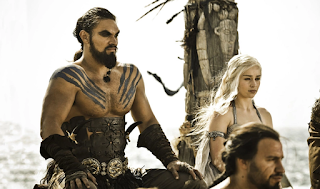Original Thought: A Brief Comparison of the Valar and Greek Gods
In beginning of The Silmarillion by J.R.R. Tolkien is a
letter by the author to Milton Waldman from 1951. In it, Tolkien illuminated some
of the ways in which he created the world and the stories within the novel. Throughout
this, he maintained that though he borrowed from certain cultures’ mythologies,
that his stories were a “given” in his mind which he wrote and largely made up.
If you look at the actual story or what could be described as mythology, it becomes
clear just how similar it is to other pre-existing mythology. The Valar in particular
were seemingly inspired by Greek mythological Gods and Goddesses.
The Valar, or the powers of Arda,
were originally thoughts by Ilúvatar, the first creator. They helped him to
create the world and were the most powerful of the Ainur. Similar to Greek Gods
and Goddesses, there were Lords and Ladies of the Valar who all served the world
as benevolent and at times tempestuous rulers (though not in comparison to the
Greek Gods), nurturers, and creators. Of these, there were two main Valar who
served as King and Queen- similar to Zeus and Hera.
Manwë, the wind-king and king of
Valar served as King of his brother and sister Valar much like Zeus served as
the head God to his brothers and sister (and children). Where Zeus ruled over
the sky more generally, Manwë served as king of air and both have been depicted
with eagles as a sort of sigil or symbol. Like Zeus on Mount Olympus, Manwë
ruled and lived on top of Mount Taniquetil. He ruled with his Queen of the Valar,
Varda.
Another Valar character, Ulmo, was similar
to the God Poseidon. Poseidon served as the God of the Sea and its creatures.
Ulmo ruled over all water. Both could come on to land, but generally preferred
to remain in the water. Though not necessarily described as carrying a trident,
Ulmo has often depicted with one and tridents were also symbolic of Poseidon.
  |
| Poseidon with his trident... and Ulmo with his. |
Oromë, the Hunstman, and his wife Vána,
the Queen of Flowers, were similar to the Huntress, Artemis. Artemis, Goddess
of the Forest, was depicted with a bow and arrow as well as deer and was
associated with nature. Both Oromë and Vána were depicted and associated with
nature and hunting and while Oromë was depicted with a bow and arrows or spear,
Vána was depicted often with deer. Oromë can be associated with the more
masculine aspects of Artemis where Vána may be more associated with the
feminine aspects.
 |
| Artemis, the Huntress |
 |
| Vana and Orome |
Though a smaller comparison, Vairë,
the weaver, was known for creating tapestries in the under world and decorated
the walls of the dead while Arachne was also a weaver known for the ill-fated contest
between her and Athena which led to her curse of turning into a spider. Another
comparison can be made for Hades and Vairë’s husband, Mandos.
Mandos was the Keeper of the House
of the Dead very similarly to Hades who was the King of the Underworld. Mandos
was the final judge of the spirits of the dead where Hades served as the ruler
of the dead.
Though the Valar are
generally more similar in position to the Gods of Greek mythology than to situation
or personality, there are clear enough, distinct features that even fan artists
for the series have created pictures of the Valar which mirror the Greek Gods. The
stories may not be exactly the same, but there are enough similarities that
there is no denying that Tolkien’s ideas were not entirely and fully his own. 




Comments
Post a Comment